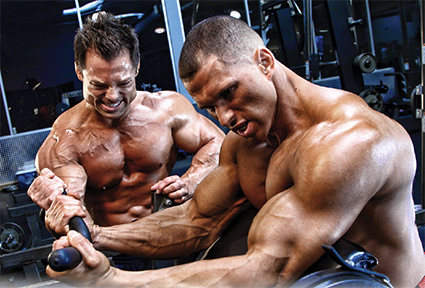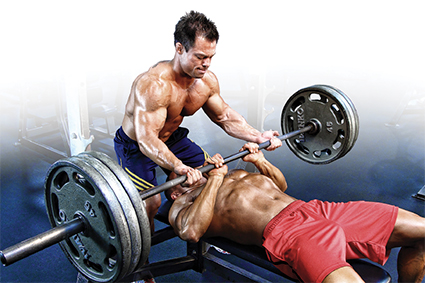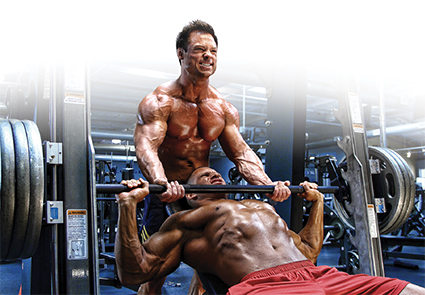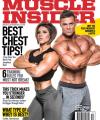The Power of Negative Thinking. Negative Reps, That Is.

One of the best, proven techniques for building muscle size and strength doesn’t come from lifting weights, but from lowering them. Here’s how to do eccentrics the right way.
Guys like you and I go to the gym to lift weights because, well, that’s what we do. We’re lifters. Imagine if someone said to you, “I hit the gym to lower weights.” I mean, what kind of silly workout is that?
Today, we’re going to zone in on, well, lowering weights. Or more precisely, the eccentric portion of the rep (alternately called the negative).
Students of the science of resistance training know that the positive (concentric) portion of the rep, the lift, is of significant importance in building muscle and strength. But it’s not the only part of the rep that matters. In fact, for each and every positive rep there’s also a negative, and there’s some real magic in focusing your training on eccentrics.
One of the main reasons negative reps have so much potential is obvious: You’re stronger lowering a heavy bar than lifting it. This means you’re able to lower a heavier load than you can lift and/or you can do more reps lowering a heavy bar than you can raising it. That’s really not all that surprising, but how it can benefit your training goals may be.
What’s a Negative?

Let’s start by explaining what’s going on over the course of a full repetition. During the lift, the action causes the muscle to shorten (aka contract, flex). So whether you’re doing a leg curl or bench press, the target muscle (or muscle group) contracts concentrically; the shortening causes movement in the joint and the weight to move upward against gravity.
For many, the lowering phase is an afterthought, but in fact it’s very much a part of the muscle contraction as well, albeit the flip side. (And yes, it’s still called a contractioneven though the muscle is being stretched!) Here, instead, the muscle lengthens as the external resistance is greater than the force being supplied.
Because many folks don’t pay much attention to the negative rep, they’re not maximizing the benefit from it. Rather than lower a weight without much thought or—[gasp] just dropping it!—the negative rep should be done under complete control at a slightly slower pace that the concentric. But when doing negatives as an advanced training tool, you’ll elongate the eccentric to as much as three to five seconds or longer.
Science Weighs In

Research tells us that from a mechanical perspective, your muscles are capable of achieving a higher absolute force—about 20 to 60 percent more force—when contracting eccentrically as compared with concentrically.1 Given that, it’s a big mistake to not consider the powerful benefits of negatives are absolutely positive.
In fact numerous studies show greater gains in muscle mass with eccentric training than with concentric only.2,3One reason for this is the greater muscle damage that occurs with eccentric training, perhaps due to the greater time under tension. Damaged muscle is thought to promote a hypertrophic response, which leads to a rapid rise in protein synthesis as well as a larger rise in insulin-like growth factor compared to concentric muscle actions.
Eccentric training can also recruit more type II (fast-twitch) muscle fibres, which have the greatest potential for hypertrophy. Evidence for this was presented in a study published in the Journal of Applied Physiologythat found eccentric training resulted in a tenfold increase in muscle size compared to concentric exercise.4It’s also been shown to elevate lactate levels, which results in an increased anabolic hormone response.5
As for increases in strength, one study indicated 5- to 15-pound increases in 1RM strength (on your positivereps!) following eccentric training using supra-maximal loads, a technique we’ll describe later.6,7
Just remember eccentric training causes more muscle damage, soreness, and acute force impairment, meaning you’ll likely be a helluva lot more sore the day or two after your workout. While that degree of soreness is reduced the more you do negative training, this method is extremely taxing to your nervous system and therefore shouldn’t be used indefinitely. At the very least, cut back on your training volume with the body part(s) you’re targeting, and don’t use this technique for longer than about six weeks.
1. Focus on Building Muscle Size

Now that you know negative training can bring absolutely positive results, let’s see how to use it in your training. To start, let’s distinguish that using negatives for building muscle is very much different than how you’d use them for building strength. While you might try either approach at one point or another, it’s important to keep the protocols separate rather than mix elements of each protocol into one.
For building muscle, eccentrics are an advanced technique that’s done at the end of your set, not unlike how you do forced reps when you reach muscle failure. Start by identifying the weight that corresponds to your target rep, typically between 8 and 12. Here, you do as many concentric (positive) reps as possible on your own with good form using the same controlled descent on every rep. Once you reach muscle failure, your workout partner then lifts the weight for you back to the top (this is nota forced rep, so he must help more than usual!) but instead of the controlled negative as you did with your previous reps, you now lengthen the negative so it lasts three to five seconds. Resist the weight by allowing it to very slowly stretch the target muscle. Do 2 or 3 reps in this manner or when you can no longer control the descent for at least three seconds.
Because this technique is so intense, you don’t want to use it on every set. Our recommendation is to use it with your heaviest and/or your last set of an exercise of each exercise in your workout. You might also want to take a slightly longer rest period between sets.
Not every exercise is suited for negatives, as you can imagine with seated overhead dumbbell presses. With a partner, it works especially well with the Smith machine. With free weights, the best exercises are ones that are easy to spot, so long as it’s safe if you were to lose control of the weights and have to bail out.
If you’re training alone, you can try it with some movements in which you use both limbs on the positive rep and then work the negative with just one side.
Example: Incline Barbell Press
The safest place to perform negatives with this exercise is within a power rack with the safety bars set to the lower end of the range of motion. To focus on building muscle, choose a weight that would elicit muscle failure by 8 to 10 reps. Complete as many reps as you can to positive-rep failure, then your partner steps in and aggressively helps you easily lift the weight for a few more reps. Now you’re going to elongate the time of each eccentric rep to five seconds, fighting to control the descent. When you simply don’t have enough strength left to resist the bar for at least three seconds, rack it.
2. Focus on Building Strength
Remember we said earlier that you’re stronger lowering a weight than lifting it? Here, we’re going using loads above your single-rep max (of the positive). You need to be well warmed up but not highly fatigued, so this is best done on 3 to 5 sets of your firstexercise only.
Use a weight that’s about 10 percent more than your single-rep max; later, as you become more proficient with this technique, you can use as much as 30 percent more than your 1RM. There are no positive reps in this sequence; you’ll be doing onlynegatives. Right from the start, your partner takes the brunt of the load in helping you raise the weight—again, this isn’t a forced rep. (Hence your partner needs to be in a position in which he has the leverage to offer substantial help.)
Just as with eccentrics for building muscle, you take three to five seconds to slowly stretch the muscle. Do no more than 4 to 6 reps in this manner for a single set. Do 3 to 5 sets in this manner, followed by 2 more sets of the same exercise using 75 to 80 percent of your 1RM (which is a load you can do for 8 to 10 reps) in normal fashion.
This protocol requires not only a longerrest period before you begin your next set (three to four minutes) but may well require a greater recovery period between workouts because of the degree of muscle damage involved. Adjust your training split as necessary.
In your workout, use this technique with a multi-joint barbell or Smith-machine movement after you’re warmed up but before other heavy sets and exercises.
Example: Incline Barbell Press
If you know your 1RM, use that number as a starting place; if you know your 8RM (that is, the weight you can do just 8 reps with), divide that weight by 0.8. So for the person who can do 8 reps at 205 pounds, his 1RM would be roughly 255 pounds. Your working weight is actually 10 percent more than that (for now), so add another 25 pounds. Thus the working weight is 280 pounds (which requires the very small 2½-pound plates on each side of the bar). Within a power rack set safeties set at the lower end of the ROM.
Your partner must help and help substantially lift the bar on each rep. Slowly lower the bar starting with the first rep, taking up to five seconds to complete the negative. Go for 4 to 6 reps, but if you can’t resist the load for at least three seconds, rack the weight. After doing 3 to 5 eccentric-only sets, do 2 more sets using a weight you can do for 8 to 10 positive reps.
References
1. Hollander DB, Kraemer RR, Kilpatrick MW, et al. Maximal eccentric and concentric strength discrepancies between young men and women for dynamic resistance exercise. J Strength Cond Res. 2007 Feb;21(1):34-40. 2. Farthing JP, Chilibeck PD. The effects of eccentric and concentric training at different velocities on muscle hypertrophy. Eur J Appl Physiol. 2003 Aug;89(6):578-86. 3. Friedmann B, Kinscherf R, Vorwald S, et al. Muscular adaptations to computer-guided strength training with eccentric overload. Acta Physiol Scand. 2004 Sep;182(1):77-88. 4. Hortobágyi T, Barrier J, Beard D, et al. Greater initial adaptations to submaximal muscle lengthening than maximal shortening. J Appl Physiol (1985).1996 Oct;81(4):1677-82. 5. Ojasto T, Häkkinen K. Effects of different accentuated eccentric loads on acute neuromuscular, growth hormone, and blood lactate responses during a hypertrophic protocol. J Strength Cond Res. 2009 May;23(3):946-53. 6. Doan BK, Newton RU, Marsit JL, et al. Effects of increased eccentric loading on bench press 1RM. J Strength Cond Res. 2002 Feb;16(1):9-13. 7. Norrbrand L, Fluckey, JD, Pozzo M, Tesch, PA. Eccentric overload appears necessary to optimize skeletal muscle adaptations to chronic resistance exercise. Eur J Appl Physiol. 2008;102(3):271-281.
